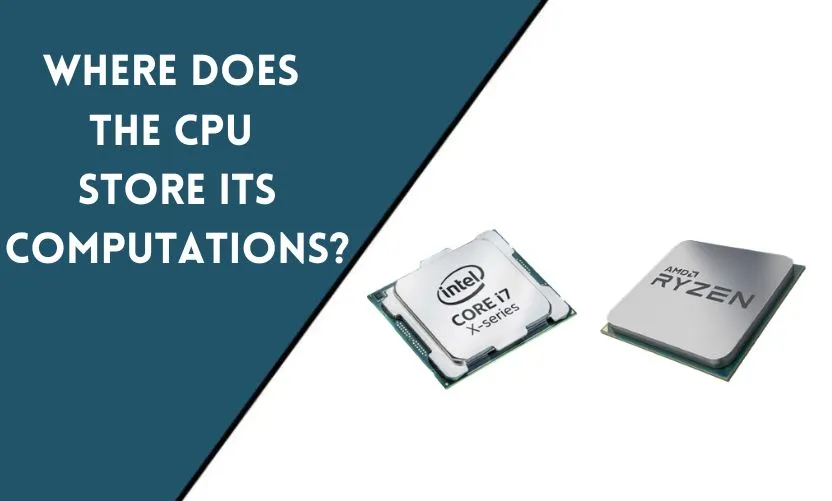
If you’ve ever used a computer, you’re probably familiar with the term “CPU”. The Central Processing Unit (CPU) serves as the core component of your computer. It’s responsible for executing the instructions that make your computer run. But where exactly does the CPU store the computations it performs? In this article, we’ll explore the various types of memory used by the CPU and how they store computations.
Understanding CPU Memory
The CPU has several types of memory, each with a different purpose. These include:
Cache Memory
Cache memory is a small amount of high-speed memory that stores frequently used data and instructions. It’s located directly on the CPU chip, which makes it extremely fast to access. Cache memory is designed to reduce the amount of time the CPU spends waiting for data from the computer’s main memory. It’s split into two levels: L1 and L2 cache.
Registers
Registers are tiny memory locations within the CPU that hold data and instructions. They’re the fastest type of memory available to the CPU, with access times measured in nanoseconds. Registers are used to hold data that the CPU is currently working on, such as the results of a mathematical calculation.
Random Access Memory (RAM)
RAM is the main memory in a computer. It’s used to store data and instructions that are currently in use by the CPU. RAM is volatile memory, which means that it loses its contents when the computer is turned off. When you open a program on your computer, the instructions and data for that program are loaded into RAM.
Read-Only Memory (ROM)
ROM is a type of memory that stores permanent data and instructions. It’s used to store the computer’s firmware, which is the low-level software that controls the computer’s hardware. ROM is non-volatile memory, which means that it retains its contents even when the computer is turned off.
How Does the CPU Store Computations?
The CPU stores computations in several ways, depending on the type of memory being used. Let’s examine each type of memory in more detail and how it stores computations.
Cache Memory
Cache memory stores computations in a way that’s optimized for speed. When the CPU needs to perform a calculation, it first checks if the data it needs is already in the cache. If it is, the CPU can retrieve the data almost instantly. This is because cache memory has extremely fast access times, measured in nanoseconds.
Registers
Registers store computations in a way that’s optimized for speed and efficiency. When the CPU performs a calculation, it stores the results in a register. Registers are extremely fast, which means that the CPU can quickly retrieve the results of a calculation and use them in further computations.
RAM
RAM stores computations in a way that’s optimized for flexibility. When the CPU needs to perform a calculation, it first loads the necessary data and instructions into RAM. The CPU then performs the calculation on the data in RAM and stores the result back into RAM. RAM is volatile memory, which means that it loses its contents when the computer is powered off.
ROM
ROM stores computations in a way that’s optimized for permanence. The data and instructions stored in ROM are permanent and cannot be changed by the user. ROM is used to store the computer’s firmware, which is the low-level software that controls the computer’s hardware.
Conclusion
In conclusion, the CPU stores its computations in several types of memory, each optimized for a different purpose. Cache memory is used for frequently accessed data and instructions, registers are used for fast and efficient storage of data, RAM is used for flexible storage of data and instructions, and ROM is used for permanent storage of data and instructions. Understanding how the CPU stores computations is important for understanding how your computer works. By having a basic knowledge of the different types of memory used by the CPU, you can better understand how your computer processes information and why certain tasks take longer than others.
Frequently Asked Questions
Can the CPU store computations in other types of memory?
Yes, there are other types of memory that can be used by the CPU, such as virtual memory and non-volatile memory.
How does the CPU decide which type of memory to use for a computation?
The CPU uses a hierarchy of memory types, with cache memory being the fastest and most frequently used, followed by registers, RAM, and ROM.
How does the CPU access data stored in RAM?
The CPU uses memory addresses to access data stored in RAM. Each piece of data in RAM has a unique memory address that the CPU can use to retrieve it.
Can the CPU store computations on a hard drive?
No, the CPU cannot directly store computations on a hard drive. Hard drives are used for long-term storage of data, not for temporary storage of computations.
Why is cache memory split into L1 and L2 cache?
L1 cache is smaller and faster than L2 cache, but it can only hold a limited amount of data. L2 cache is larger and slower than L1 cache, but it can hold more data. The split between L1 and L2 cache is designed to make a balance between speed and capacity.










